16 The Beginnings of Medical Technology
Makenzie Steele
16.1 Introduction
Keywords
- Folk medicine – medical procedures that relied on the use of plants and herbs for healing properties
- Placebo effect – a harmless medicine or treatment given to a patient with the intent of making them feel better merely due to the psychology of them believing the medicine will heal them
- Electrocardiogram – a machine used to provide the simplest and quickest information about the heartbeat by placing electrodes onto specific areas of the body. They are connected by wires to an ECG machine where the heartbeat is measured by the pulses it sends
- Electroencephalogram (EEG) – a way of measuring brain disorders through the use of electrodes in which pulses sent by the brain cells are recorded as wavy lines on the EEG machine
- Cardiac Defibrillators – devices that bring back the normal heartbeat of a person by sending electric pulses or shocks to their heart
- Pacemaker – medical devices that generate electrical impulses delivered by electrodes to the heart to cause the muscle chambers to beat and pump blood, in turn regulating or replacing a regular heartbeat
- Computed Tomography Scanner (CT Scan) – these machines combine a series of X-ray images taken from different angles of the body in order to make more detailed photos of the internal bones, blood vessels, and soft tissues by using computers to put multiple images together into one cross sectional photograph
- Magnetic Resonance Imaging (MRI) – these scanners use magnetic fields and computer generated radio waves to get detailed photos of organs and tissues in the body
- Technological Determinism – the idea that a society’s technology determines the development of its social and cultural values
Learning Objectives
By the end of this chapter, students should be able to:
- Describe the origins of medicine in ancient times.
- List different medical technology milestones that occurred in the 1800’s to 1900’s.
- Explain the influence of the various medical milestone’s on future medical advancements.
- Identify examples of accidental medical inventions and explain their importance.
- Summarize the effects that past medical technologies have on today’s world.
Imagine you have a doctor’s appointment tomorrow for a check up. First, you arrive at the office, they record your height and weight, you wait for the doctor, then the inspection begins. The doctor takes out all their tools and begins listening to your heartbeat through a stethoscope. The stethoscope seems like such a simple technology, but it has shaped the way we do things today, even 206 years after its invention. Have you ever thought about what people did before modern doctors and medicine? My guess is probably not, because we don’t often think about the historic progression that got us to where we are today.
Before diving into the depths of this section about more complex medical technologies such as telehealth, genetic engineering, machinery, and more, it is important to first recognize and understand where the origins of our current medical technologies stemmed from. The advancements in medical technology that greatly impact the world of medicine today have been achievable through the foundation set by the inventors of these various technologies which continue to save lives. In this chapter, we are going to gain a better understanding of this strong foundation through investigating the very first medical practices, meaningful milestones in medicine, accidental but influential medical inventions, as well as the effects these each have on our current society.
16.2 Back to the Roots
Key Takeaway
Before the year 1800, medicine and surgical procedures were much simpler than they are today. Back then, humans
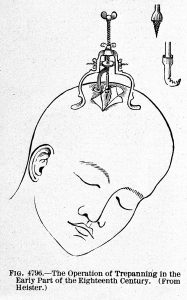
“Trephining, from Buck “Reference handbook…”, 1904″ by Wellcome Images is licensed under CC BY 4.0
relied more on methods such as trial and error and experimentation. This was especially prevalent in their usage of plants in their medical practices. They did not know which were poisonous, which were edible, and which had helpful medicinal properties. This is referred to as folk medicine or domestic medicine, meaning that people relied on vegetables and herbs in order to heal others. This type of medicine was used for more ordinary and mild illnesses like the common cold. Folk medicine is one of the most ancient practices in history used by doctors.
Other stronger and more impactful illnesses were not addressed by these herbal remedies, though. Instead, harmful disorders were viewed as coming from a supernatural origin. In other words, people thought others with disabilities had spells and curses cast upon them. They also believed stones or sticks were placed into the body and soul by upset Gods or demons into those people with the severe diseases. The treatment for this was to “extract” the curses via counterspells, potions, suction, or other intriguing methods like trepanning shown in Figure 16.1.
Herbal remedies were also accompanied by other religious and magical beliefs. People referred to as “medicine men” or “witch doctors” were usually the ones to administer the herbal drugs to the patients. “Medicine men” were recognized as sorcerers who would give incantations, perform dances, and do other tricks to aid in healing processes. While none of these methods are practical or useful today, it is important to recognize how far medicine has come since then. These practices displayed the wisdom of doctors back in the day. This wisdom is seen through their abilities to make people feel better with their treatment to both the soul and body of their ill patients. Because the doctors didn’t do much physical change to the body, it is interesting that they still could make their patients feel as if they were healed. This idea can relate to the placebo effect. This is when the treatments or drugs given to patients make no changes to the body, but the patient feels better because they believe the drug has healing power (Rhodes, Guthrie, Richardson, Underwood, Ashworth, Thomson, & Robson, 2020).
16.3 Medical Milestones
Key Takeaway
16.3.1 Magnifying Glass – 1250
The magnifying glass might not seem like a technology at first. But it is a tool used to solve problems and provide help, therefore it is considered a technology. So, it is important to recognize when the simplest of technologies came into play. English philosopher Roger Bacon is credited with the creation of the first magnifying glass. While crystals had been used for magnification in history, Bacon was the first to use a convex lens designed for scientific purposes. This technology is seen everywhere today from regular eyeglasses for the common citizen to microscopes used by high level scientists and surgeons (Bakalar, Barrow, Huang, & Parker, 2012).
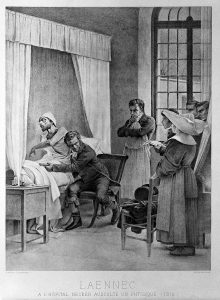
“Laennec and the use of the stethoscope at the Hospital Necker” by Wellcome Images is licensed under CC BY 4.0
16.3.2 Stethoscope – 1815
Although the stethoscope has definitely been refined to the version we use today, the same technology originated over 200 years ago. One day, French physician René Laënnec could not hear the heartbeat on one of his overweight patients by the usual method of pressing his ear to her chest. To solve the problem, he assembled the first stethoscope from a trumpet-shaped wooden tube. (Bakalar, Barrow, Huang, & Parker, 2012).
16.3.4 X-Ray – 1895
Wilhelm Conrad Röntgen was a German physicist who was the first to discover the X-ray. A surprising piece about this invention was that Röntgen was not intending to make this discovery. This invention did not seem impactful at the time, but the prevalence and reliance on this device today tells us otherwise. X-Rays have become vitally important not only for observing broken bones, but also addressing other illnesses and injuries as well. Alterations of the same technology have been used to create mammograms to search for breast cancer, and chest x-rays are used to diagnose pneumonia. The one drawback of x-rays is that they can’t show the brains of living patients due to the surrounding dense bone making up the skull. So in the past when doctors believed a patient had a brain tumor, they went straight into performing dangerous exploratory surgeries without even knowing the root of the problem. This technology later influenced the creation of the CT scanner in the 1970s.
16.3.5 Electrocardiogram (ECG) – 1903
An electrocardiogram is a machine used to provide the simplest and quickest information about the heartbeat. Electrodes are placed onto specific areas of the body connected to an ECG machine where the heartbeat is then measured by the pulses it sends. From the Netherlands, Dr. Willem Eintoven invented the first version of this machine. His model included a water cooling system for the large electromagnets. Its weight was around 600 pounds and operation required five people (Bakalar, Barrow, Huang, & Parker, 2012).
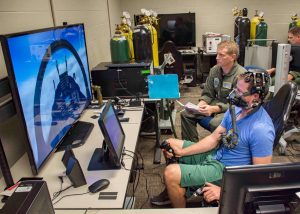
“Lt. Clayton Shaw, an instructor pilot from Training Squadron Ten (VT-10) participates in a research project using new Electroencephalogram (EEG) “ by Picryl is in the Public Domain, CC0
16.3.6 Electroencephalogram (EEG) – 1924
An electroencephalogram (EEG) is used today for brain diagnostics such as epilepsy, tumors, and other disorders. It detects the electrical activity in the brain by using electrodes attached to the scalp which measure electrical pulses created by the brain cells. The electrical activity shows on the machine as different types of wavy lines which are read and interpreted by the doctors. In Germany, Dr. Hans Berger was the first to record a human electroencephalogram. He knew the brain had electrical pulses that could be recorded, so he sought out the method to do so, despite the ridicule he received for his idea. After five years, he finally published the technique of being able to measure human brain activity via the surface of the head (Bakalar, Barrow, Huang, & Parker, 2012).
16.3.7 Cardiac Defibrillators – 1947
Cardiac defibrillators are used to restore a normal heartbeat by sending electric pulses or shocks to the heart. Claude Beck, a cardiovascular surgeon in Cleveland, was the first to bring back the heartbeat of a patient through the use of a defibrillator. While the principle of defibrillation had been known in past decades, this was the first successful application of the technology (Bakalar, Barrow, Huang, & Parker, 2012).
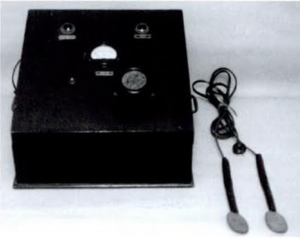
“Defibrillator used by Claude Beck in 1947.” by John Field is licensed under CC BY-SA 4.0
16.3.8 Pacemaker – 1958
Pacemakers are medical devices that aid in the heart’s function of pumping blood. Electrodes generate electrical impulses to the heart muscle chambers to make them beat. Pacemakers are still commonly used today, especially in patients who have arrhythmias, a problem or irregularity of one’s heart rate. Wilson Greatbatch, an engineer from New York, is the creator of this life changing and life saving device. Similar to the X-ray, Greatbatch’s mistakes in his research led him to his discovery. According to the American Heart Association, more than half a million pacemakers are implanted every year, showcasing the great influence of this technology (Morrison, 2015).
16.3.9 Fetal Ultrasound – 1958
A commonly used technology for pregnant women today is the fetal ultrasound. Dr. Edward Hon from Yale was the first to use this technology for prenatal care while utilizing a Doppler monitor on a woman’s stomach. With this technology he realized he could detect the heartbeat of her fetus. The principles of ultrasounds had been known for years prior because Swedish physicist, Christian Andreas Doppler, had given the name to the technology back in 1842 as it was used for different purposes (Bakalar, Barrow, Huang, & Parker, 2012).
16.3.10 Computed Tomography Scanner (CT Scan) – 1971
A computed tomography (CT) scanner is a more detailed version of an X-ray. These machines combine a series of x-ray images taken from different angles of the body to be able to see bones, blood vessels, and soft tissue all in one cross sectional photograph. This invention was made by the influences and ideas of different inventors over the years. Allan Cormack and Godfrey Hounsfield are the two main men credited with this invention. This technology began to take shape when Cormack noticed that doctors relied on their charts by assuming all kinds of human tissues (bones, muscles, fat, etc.) absorbed radiation the same. This was discovered not to be the case. Cormack soon designed a “map” of the human body to distinguish the different levels of radiation absorption by the different tissues. While Cormack was doing his work, Hounsefield was working for a computer company, just what Cormack needed. Hounsefield made similar discoveries to Cormack about hitting objects with radiation at different angles to gather more data about that object. After further collaboration and experimentation, the first CT scan was used on a woman to discover her brain tumor using their technology (Morrison, 2015).
16.3.11 Magnetic Resonance Imaging (MRI) – 1978
Magnetic resonance images (MRI) produce detailed images of organs and tissues in the body by using magnetic fields and computer generated radio waves. Dr. Raymond V. Damadian, American physician of Armenian descent, was the first to patent his technique of using nuclear magnetic resonance imaging in order to tell apart normal and cancerous tissue in the body. MRI’s are very common today among athletes to detect muscular injuries. But there are still plenty of average people who benefit from MRI’s in order to discover injuries that are not bone related, but rather damages to muscles or organs (Bakalar, Barrow, Huang, & Parker, 2012).
16.3.12 Artificial Liver – 2006
British scientists Dr. Colin McGucklin and Dr. Nico Forraz from Newcastle University were the first to develop a liver grown from stem cells in a lab. This discovery was made more recently in 2006. Their “mini liver” was merely the size of a small coin. Therefore, it was not a full organ that could be implanted in a human. After this initial discovery, the same technique employed by these scientists can be used to develop a full-sized liver for implantations (Christensen, 2006).
16.4 Accidental Inventions
Key Takeaway
16.4.1 Wilhelm Conrad Röntgen’s First X-Ray
As mentioned earlier in this chapter, Röntgenan’s invention of the x-ray was not intentional. His general research focused on elasticity, capillary action of fluids, specific heats of gases, conduction of heat in crystals, and piezoelectricity. Back in 1895, Röntgenan was experimenting with electric currents in cathode-ray tubes. Through his observations on the tubes, he noticed that a certain chemical gave off light when he operated on the tube. This led to his idea that when cathode rays hit the tube walls, radiation was made, which then struck the special chemical, causing fluorescence. After more complicated experimentation, he was able to take the first x-ray photographs. These photos were of the interiors of metal objects and the bones in his wife’s hand. Once published, his findings seemed so impressive that many did not believe his reports. The New York Times even referred to it mockingly as “Dr. Röntgen’s alleged discovery of how to photograph the invisible,” (The Editors of Encyclopedia Britannica, 2021). This mockery has been proven wrong as x-rays are one of the most widely available diagnostic imaging tools available today.
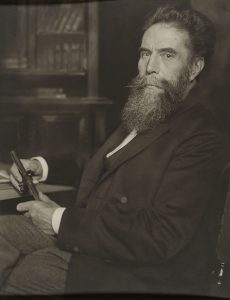
“Wilhelm Conrad Röntgen – Physiker” is in the Public Domain, CC0
16.4.2 Wilson Greatbatch’s First Implantable Pacemaker
Similar to Röntgenan’s unintentional discovery, the implantable pacemaker by Wilson Greatbatch was also an unplanned discovery. It all started when Greatbatch realized there was a problem with the cardiac condition of complete heart block. Through this research, his idea of how to make a pacemaker came to life from an accidental realization. He initially thought about creating an external pacemaker to regulate heartbeats. But he knew there had to be another way to live without being stuck beside a machine the rest of your life. He sought out for something with smaller tubes and pipes that the patient could deal with easier. Later in 1956, he was an assistant professor at the University of Buffalo and worked on a device to record heart rhythms. One day, Greatbatch accidentally installed the wrong sized resistor in the device. This accident led to his important realization. The electronic device made a series of quick pulses, similar to a heartbeat, which reminded him of his pacemaker dilemma. By May of 1958, he created a smaller pacemaker prototype that controlled a dog’s heartbeat. Beforehand, many doctors looked at complete heart block as an incurable disease. With Greatbatch’s invention, all would be changed. After two more years of improvements, his pacemaker had been implanted in ten humans, two of which were children. To this day, refinements have continued to be made, but the ultimate discovery by Greatbatch has had a critical impact on many lives.
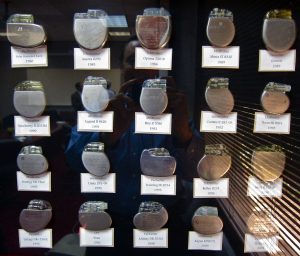
“The Pace of Pacemakers” by Steve Jurvetson is licensed under CC BY 2.0
16.5 Effects on the Future
Key Takeaway
From the stethoscope to the artificial liver, each invention has its place in today’s world. Now that we know the importance of historical technologies in today’s world, we can see the importance that current technologies have on the future. Some view our current technologies as a way that shapes the success or progression of our society. This is referred to as technological determinism, the idea our technologies influence our society and cultural values. For example, if we can detect and intervene with the human body by creating artificial organs for implantation, then maybe our medical culture will shift to creating new organs instead of saving organs we already have. Dr. Willem J. Kolff was a pioneer in hemodialysis, the artificial heart, as well as the entire field of artificial organs. His inventions have saved many lives and in an interview he shared his thoughts on a scientists’ responsibility to society. He stated, “I think that we should use our influence to make society a better place for all of us to live in.” He spoke about this idea when he compares his invention of the artificial heart to the invention of nuclear bombs. He said, “What good does an artificial heart do for you if we are all pulverized [by atomic bombs]?” In saying this, he means that it is what we do with our discoveries that impact us most. If we use nuclear energy to create bombs and harm others, he is saying scientists have not fulfilled their deed to society. If we use technological inventions for more harm than good, then scientists are not playing their proper role. Yet, in the medical field, it’s uncommon for someone to work on a discovery that saves lives only to hide it from the world. Most of the motivation behind these medical discoveries are for the greater good of the people, just like Kolff said.
Furthermore, not all technologies stay in the medical field. An example is the use of CT scanners in other areas of study like archaeology and security. In addition to doctors’ offices, CT scanners are found when you go through security at an airport for safety. The scanners are used to search your bags for any hazardous materials or dangerous objects, because the same technology applied to the different tissues applies to the different densities of objects. There are so many more discoveries that continue to be made, both intentionally and unintentionally, that have an impact on our lives. Later in this section, you will dive into the more advanced technologies of recent decades. But make sure to keep in mind where the initial technologies came from and how they have shaped our discoveries and lives today.
Chapter Summary
Over the course of history, medical practices and technologies have come a long way. The advancements and innovations in medical technology have greatly impacted the world of medicine we currently know and rely on. This has been achievable only through the strong foundation set by the inventors of various technologies. While the origins of medicine seemed to rely on the placebo effect of witchcraft and magic, it is still important to recognize where it all began with folk medicine. Progressing through the years, the initial medical technologies such as the magnifying glass and stethoscope were merely created to solve simple problems doctors had faced. As problems became more complex, so did the required solutions. Hence, newer technologies were invented and continue to be in use today. For example, the various diagnostic imaging techniques like the x-ray, MRI, and CT scanner invented in the 1900s are now commonly used in modern diagnostic medicine. While some were not invented according to plan, their influence and impact is just as crucial for all of the lives they have saved. Lastly, medical technologies have not only impacted the medical field, but also other fields of study like archaeology, security, and more.
Review Questions
1. Who were the original “doctors” referred to as during the early years of medical procedures?
A. Physical Healers
B .Medicine Men
C. Sorcerers
D. They did not have people in doctoring positions
2. Which medical technology milestones are used with electrodes?
A. Electrocardiogram
B. Electroencephalogram
C. Pacemaker
D. All of the above
3. Which technology influenced the future creation of the CT Scanner and why?
A. The x-ray because it was old.
B. The electroencephalogram because it creates waves measuring brain pulses.
C. The x-ray because the skull bone was too dense to see into the brain.
D. The electrocardiogram because the heart measurements were not accurate.
4. Which of the following inventions was discovered unintentionally?
A. Pacemaker
B. Stethoscope
C. Magnetic Resonance Imaging
D. Electrocardiogram
5. Which of the following technologies is still used today (refined versions)?
A. Stethoscope
B. X-Ray
C. Pacemaker
D. All of the above
Answers
- B
- D
- C
- A
- D
Food for Thought
- Think back to the invention of the x-ray. As mentioned, one of its flaws was that the skull bones were too dense to scan through, but this led to the creation of the CT scanner. Are there any flaws in specific technologies you can think of today that might lead to technological inventions in the future?
- Similar to what Dr. Kolff said about artificial hearts not meaning anything if nuclear bombs are misused, are there any current medical technologies you are worried about having a negative impact on society?
References
Bakalar, N., Barrow, K., Huang, J., & Parker, D. (2012, October 10). Milestones in medical technology. The New York Times. Retrieved November 4, 2021, from https://archive.nytimes.com/www.nytimes.com/interactive/2012/10/05/health/digital-doctor.html?ref=thedigitaldoctor#/#time15_375
Britannica, Editors of Encyclopaedia. (2021, June 26). Wilhelm Conrad Röntgen. Encyclopedia Britannica. https://www.britannica.com/biography/Wilhelm-Rontgen
Christensen, B. (2006, October 31). World’s first artificial human liver grown in lab. LiveScience. Retrieved November 18, 2021, from https://www.livescience.com/4276-world-artificial-human-liver-grown-lab.html.
Hopkins, J Medicine. (n.d.). Electrocardiogram. Johns Hopkins Medicine. Retrieved November 17, 2021, from https://www.hopkinsmedicine.org/health/treatment-tests-and-therapies/electrocardiogram.
Kolff, Willem. (2016, November 7). Dr. Willem J. Kolff, Academy Class of 1971, Full Interview. Youtube https://www.youtube.com/watch?v=aTXe7RKCRvM
Mayo Clinic Staff. (2020, April 15). EEG (electroencephalogram). Mayo Clinic. Retrieved November 17, 2021, from https://www.mayoclinic.org/tests-procedures/eeg/about/pac-20393875.
Morrison, H. S. (2015). Inventors of health and medical technology. Cavendish Square Publishing LLC.
Rhodes, P. (2020, August 27). History of medicine. Encyclopedia Britannica. https://www.britannica.com/science/history-of-medicine
Rush, B. (1774, February 4). An oration, delivered before the American Philosophical Society: An enquiry into the natural history of medicine among the Indians in North-America, and a comparitive view of their diseases and remedies, with those of civilized nations. Printed by Joseph Crukshank in Market-Street, between Second and Third Streets.
Van Wagenen, J. (2021, September 8). Who invented the defibrillator: The response tech against sudden cardiac arrest. Technology Solutions That Drive Healthcare. Retrieved November 17, 2021, from https://healthtechmagazine.net/article/2017/08/defibrillator-jump-started-cardiac-arrest-survival.
Medical procedures that relied on the use of plants and herbs for healing properties.
A harmless medicine or treatment given to a patient with the intent of making them feel better merely due to the psychology of them believing the medicine will heal them.
A machine used to provide the simplest and quickest information about the heartbeat by placing electrodes onto specific areas of the body. They are connected by wires to an ECG machine where the heartbeat is measured by the pulses it sends.
A way of measuring brain disorders through the use of electrodes in which pulses sent by the brain cells are recorded as wavy lines on the EEG machine.
Devices that bring back the normal heartbeat of a person by sending electric pulses or shocks to their heart.
Medical devices that generate electrical impulses delivered by electrodes to the heart to cause the muscle chambers to beat and pump blood, in turn regulating or replacing a regular heartbeat.
These machines combine a series of X-ray images taken from different angles of the body in order to make more detailed photos of the internal bones, blood vessels, and soft tissues by using computers to put multiple images together into one cross sectional photograph.
These scanners use magnetic fields and computer generated radio waves to get detailed photos of organs and tissues in the body.
The idea that a society's technology determines the development of its social and cultural values.

